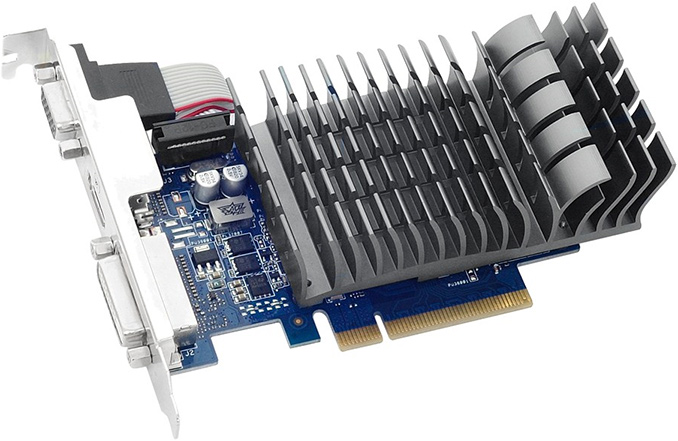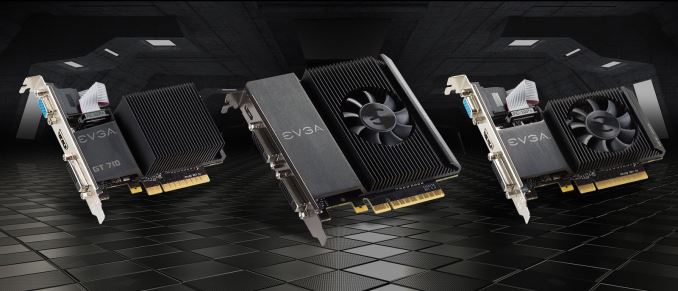NVIDIA’s Partners Roll-Out GeForce GT 710 to Fight Integrated Graphics
by Anton Shilov on January 27, 2016 1:07 PM EST
Advancements made by iGPUs by AMD and Intel in the recent years essentially destroyed the market of inexpensive discrete video cards. High-performance iGPUs can outperform low-end standalone graphics adapters these days and for a lot of users performance of integrated graphics is enough. Nonetheless, there's still a smaller market for low-end add-in boards - notably as upgrades to true entry-level PCs - and to that end NVIDIA’s partners this week released a new breed of low-end graphics cards targeting entry-level PCs.
The new NVIDIA GeForce GT 710 video cards are based on a cut-down version of the company's existing GK208 GPU, with 192 stream processors, 16 texture units and 8 ROPs. As this is a Kepler architecture product, you'll find baseline support for Direct3D feature level 11_0 but not newer features found in the Maxwell generation such as HDMI 2.0, which is likely why NVIDIA opted to launch this as a 700 series product. Peak compute performance of the GPU when clocked at 954 MHz is around 366 GFLOPS, which is below that of contemporary higher-end iGPUs by Intel or AMD. The GeForce GT 710 graphics cards are equipped with 1 or 2 GB or DDR3-1800 memory featuring 14.4 GB/s bandwidth.
| NVIDIA GPU Specification Comparison | ||||||
| GT 710 | GT 720 | GT 630 | GT 610 | |||
| CUDA Cores | 192 | 192 | 192 | 48 | ||
| Texture Units | 16 | 16 | 16 | 8 | ||
| ROPs | 8 | 8 | 16 | 4 | ||
| Core Clock | 954MHz | 797MHz | 875MHz | 710MHz | ||
| Shader Clock | N/A | N/A | N/A | 1620MHz | ||
| Memory Clock | 1.8GHz DDR3 | 1.8GHz DDR3/ 5GHz GDDR5 | 1.8GHz DDR3 | 1.8GHz DDR3 | ||
| Memory Bus Width | 64-bit | 64-bit | 64-bit | 64-bit | ||
| VRAM | 1GB or 2GB | 1GB or 2GB | 1GB or 2GB | 1GB | ||
| TDP | 19W | 19W | 50W | 29W | ||
| GPU | GK208 | GK208 | GK107 | GF119 | ||
| Launch Timeframe | January, 2016 | March, 2014 | April, 2012 | May, 2012 | ||
| Launch Price | $30 - $50 | $49 | OEM | $49 | ||
Makers of graphics cards position their NVIDIA GeForce GT 710 boards as solutions for entry-level PCs running Intel Celeron or Intel Pentium processors with mediocre iGPUs, and these are typically the comparisons you'llsee vendors make as it doesn't take much to surpass low-end iGPUs. That said, while the GeForce GT 710 can indeed be considerably faster than outdated integrated GPUs, it is unlikely that it can enable decent performance in demanding video games, and this is more likely to be pitched as a card for MOBAs and similar low-impact games.
From a sales perspective, since the GK208 GPU is not a new graphics chip - having been launched back in 2013 - it is somewhat surprising to see that virtually all partners of NVIDIA decided to release their new video cards powered by the GPU. The market for such adapters is very limited these days because 100% of entry-level PCs use iGPUs. Moreover, even in countries like China, where inexpensive hardware is sold in large quantities, more and more gamers are adopting higher-end discrete video cards, according to media reports.
Meanwhile from a technical perspective, as the GeForce GTX 710 are designed for low-end PCs, many of such video cards come in half-height/half-length form-factor. Typical for low-end cards (especially those expected to sell well in the APAC market), all of the GT 710s we've seen so far feature D-Sub analogue monitor output for compatibility with older monitors, along with the more typical DVI and/or HDMI/DP connectors. Meanwhile GT 710 is rated for a TDP of just 20 W, so many of the cards use passive cooling solutions, while the rest feature small fans.
The NVIDIA GeForce GT 710 graphics cards are available from companies like ASUS, EVGA, Galax, Gigabyte, Inno3D, Palit Multimedia, Manli, MSI, ZOTAC and some others. Prices of the GeForce GT 710-based graphics adapters vary, but typically such cards cost from $30 to $50 in the U.S.











60 Comments
View All Comments
yannigr2 - Saturday, January 30, 2016 - link
400/500 series where competitive with 600/700 series that had twice the cores.http://www.anandtech.com/bench/product/1337?vs=112...
Also when having to do with so low bandwidth, you can always end up with that garbage performing better than the newer version, just because of the over 20-28GB/sec bandwidth. The worst option here is the 64bit+DDR3 Kepler card, not the Fermi one.
SkipPerk - Friday, February 5, 2016 - link
This is a good point. Even the GTX 640 can be pretty awful for the price. Usually you are always better going AMD below $100 (I currently have a GTX970, so I'm no AMD fanboy).The old 7750 and 6750 were great cards for cheap, as was the 7790. I recall seeing a 7750 on sale at BestBuy once for $50. The GTX 640 was $100.
BrokenCrayons - Thursday, January 28, 2016 - link
Typo in the 5th paragraph, 1st sentence which reads "Meanwhile from a technical perspective, as the GeForce GTX 710..." Shouldn't the GTX be a GT instead?ImSpartacus - Thursday, January 28, 2016 - link
Definitely not. This is a high end gtx graphics card for sure. This is how you get all the fast colors.BrokenCrayons - Friday, January 29, 2016 - link
Ah, my mistake. You're completely correct. The new GTX 710 will make all other GPUs released before it look shamefully slow by comparison. I don't know what I was thinking. ^.^Anato - Thursday, January 28, 2016 - link
<15W, Passive cooled, HDMI 2.0, HDCP 2.2 and DP and I'd buy 2I don't know why these low end cards are always 2+ years behind. These are well suited to make old computers drive big screens like TV:s etc. Don't need performance, I need new interfaces and low power.
A5 - Thursday, January 28, 2016 - link
Amortizing development costs and old chips are cheaper to make. From a business view, it is pretty simple.And no one who "needs" HDMI 2.0 to drive a 4K display is going to buy a $30 video card.
SkipPerk - Friday, February 5, 2016 - link
You might be surprised. I met a guy with a high-end graphics card who did not game. He was using the DVI off the motherboard to the monitor. He had no idea. He just had a large, expensive graphics card as well as the power supply to drive it for no other reason than looks.qlum - Thursday, January 28, 2016 - link
The selling pont for me of those low end gpu's has generally been to bring tripple monitor setups to low end office pc's and for the people who need adobe shit (it crashes when running displays on both the igpu and the gpu) I use sapphire flex ones that are also rather inexpensive. Not everyone really needs good gpu performance.firerod1 - Thursday, January 28, 2016 - link
This card is good because of the 3 different display connections, I've used plenty of low end cards like this at the places I work at as their IT guy. Works great for workstations that want dual monitors and such.